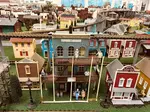Painting Models of Buildings for Your Train Layout

One of the most important things to remember about painting models for your train layout is to keep the colors realistic. Most prototypical structures appear in flat or muted colors, almost never in the bright colors that many of the ready-made model buildings come in that you buy at the hobby shop. So, if you want a realistic-looking building, you will most likely need to paint it, whether you buy it as a “built-up”, as a kit, or if you scratch build it.
Painting ready-made buildings
If you’ve purchased a “built-up” (already built) structure, there will probably be several detail parts that have already been glued on. You will either have to mask these details with masking tape or airbrush the whole structure, then hand-paint the detail parts afterwards.
___________________________________
Painting model kits
If you have a kit to put together and you wish to change the colors, in many cases, it’s helpful to paint the parts while they are still on the sprue.
Most of the time the plastic comes out of the box shiny with oils from manufacturing and handling. Before painting, wash the plastic parts in soap and water, being careful not to lose any small pieces. That will provide a better surface for the paint to adhere to. Many people routinely use a flat gray latex primer before applying the final color.
Airbrushing is a great way to paint plastic models and is usually the recommended method. You can use a brush and follow the lines of the wood or bricks to mask the brush marks, but usually airbrushing will give you a better result.
Follow the directions regarding painting that came with the kit, if there are any. Sometimes, it will be better to go ahead and put together the basic parts of the structure first, then airbrush it. This keeps the glue from messing up your paint job when you put it together.
Then airbrush the detail parts on the sprue using another color before gluing them to the model.
Some kits come with the details, like windows and doors already molded in the plastic walls. In this case you should paint the whole structure first with 2 thin coats of the color you prefer for the main structure, then carefully mask around the details and paint them with a small artist's brush (or an airbrush if you have a thin nozzle and are well-practiced in airbrushing).
_________________________________
Painting models of brick buildings
If you have a brick building, that you have painted a brick color, and you really want it to look like brick rather than painted plastic, apply a wash of mortar-colored paint.
Use 1 part paint to 6 parts thinner, or even more thinner for darker colors. Make sure this is mixed well.
Then brush the mixture evenly over the “brick” surface of the model building.
When the wash dries, you will notice that some of the mortar color is on the face of the bricks where you really don’t want it. Take an eraser or even a soft damp cloth and rub over the surface of the brick faces to remove the mortar color. After this is completed, if you like, you can use different shades of brick color and with a small artist’s brush, paint a few individual “bricks” here and there to add some variety in the brick wall, just like in real buildings.
Then paint the trim or other details of the building.
_________________________________
Painting models of buildings with lights
If you’re planning to put a light in the building, don’t forget to paint the insides of the walls and inside of the roof black so the light doesn’t shine through the plastic when you turn it on. Nothing destroys the realism of a building as much as that does.
________________________________
Painting models of wood structures
For wood structures, paint all the parts first with a latex primer. Then, after this dries, paint all the parts whatever colors you wish before putting them together. You can use either an airbrush or a regular brush. Apply the paint thinly at first. It’s best to use 2 thin coats rather than one heavy coat to avoid warping the wood.
________________________________
Painting models with wood siding or deck flooring
Some kits have plastic walls that simulate wood siding or deck floors, but the plastic doesn’t really look much like wood. You can improve the appearance by blending shades of tan, brown and black using washes or dry brushing. You can also add chalk to highlight individual boards intermittently.
_________________________________
Weathering
Using washes and/or chalks are great methods for weathering structures as well. Prototype photos are helpful in choosing and applying the appropriate colors in the right places.
From "Painting Models" to "Model Railroad Buildings"
From "Painting Models" to "Homepage"
Tracks Newsletter: Sign Up Here!
√ = ad or sponsored link
What's New on BYMRR.com?
Recent Articles
-
Model Railroad Supplies
Dec 16, 25 03:46 PM
We have started a new store to help you build your layout and teach your youngsters about science with STEM products. -
DC and/or DCC on the Same Layout
Mar 09, 25 10:46 AM
How to wire your layout for either DC and/or DCC operation. -
Looking for a locomotive speaker
Nov 24, 24 07:29 AM
First Name: Randy E-Mail Address: bymrr@building-your-model-railroad.com Enter your question: : I am looking for a speaker for a Walthers EMD SD70ACE Locomotive, product number 910-9866. The control b…







